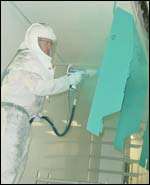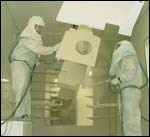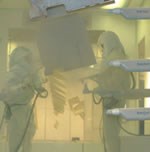Sweeping Up Productivity Gains
Good planning and a switch to powder pay off at Tennant
#curing #management #masking
Anyone who’s spent much time in a manufacturing plant has probably seen the products in action. The familiar blue-and-white sweepers and scrubbers produced by Tennant Company (Minneapolis) keep floors clean in facilities around the world. The company’s products range from commercial vacuums to manual and powered walk-behind sweepers and scrubbers to large sweepers able to clean more than five acres per hour.
Tennant also produces outdoor cleaning equipment, floor polishers and extractors, wet/dry vacuums, and other specialty cleaning equipment—all told, more than 10,000 part numbers. And about 80% of those parts require an organic finish, according to Paint Process Engineer Mike Reznicek. “We paint everything from sheet metal parts to a flame-cut part 2-1/2 in thick,” he says. “Parts are all steel—mostly cold-rolled, some hot-rolled, and many have complex features produced by laser cutting.”
Featured Content
And, he adds, until recently Tennant’s paint line was a source of multiple headaches. For starters, the line lacked capacity, forcing Tennant to outsource a significant portion of its painting requirements. Then there was the U.S. Environmental Protection Agency’s upcoming maximum achievable control technology (MACT) deadline for the line’s VOC emissions—a potential problem that Reznicek and other Tennant managers chose to view as an opportunity.
“We were following the MACT process, and once the rule was published we had a three-year time clock running,” he recalls. “So we knew all the way back in mid-2002 that we had to do something, and at that point we began examining our options.”
Those included thermal oxidizers, low-VOC paint, powder coating and 100% outsourcing. “We did an analysis of how each option would impact our business in terms of operating expenses, capital expenditures, space and other factors,” Reznicek says. “We did the due diligence, and we chose to switch from liquid to powder coating.”
Selection Process
Tennant was also rigorous in its selection process for a supplier of the new line. “Once we chose the powder option, we looked at many vendors,” Reznicek says. “We selected three system vendors to do hard quotes. We did a lot of interviewing and site visits. We developed a questionnaire for other customers of the potential suppliers. It included questions on feedback, implementation, delivery, quality, overall satisfaction and other factors. There were a number of other criteria as well.”
Over the course of several months, Tennant eliminated one of the three prospective suppliers, then asked the other two for more complete system drawings. “This went down to what kind of controls they were using, what kind of pumps and so on,” Reznicek recalls. “We flew around the country and looked at systems they had done, looking at all aspects of their projects.”
As a result of this process, Tennant chose A.B. Myr Industries (Belleville, MI) to be the supplier of its turnkey powder coating system. Once again, planning well ahead of the mid-2005 MACT deadline paid off, according to Reznicek. “We had a year to do the engineering and a lot of the fabrication before installation,” he explains. “It took us longer to prepare the site than it took A.B. Myr to fabricate and install the system. We had to vacate 22,000 sq ft of our facility, and we could tolerate no disruption to production. So the powder system had to start up while the wet system was still running.” The Minneapolis plant is the only Tennant manufacturing facility in the United States that does painting, Reznicek adds.
System Details
The result of all that planning was a system that meets Tennant’s current requirements and also allows for future growth. “Management asked us to build in capacity to handle 6% growth for the next five years,” Reznicek says. “So, as our company grows, we already have capacity to handle it.”
Tennant’s process begins with an eight-stage pretreatment line. After an alkaline wash and rinse, an acid descaling process further cleans parts and readies them for subsequent processing. “The acid descaling is a spray process that removes oxides left on parts from laser cutting process,” Reznicek explains. “No coating will stick to that oxide, so we use the acid to actually remove enough of the oxide to allow powder adhesion to the laser-cut edges.
Acid descaling is followed by a neutralizing rinse, clean water rinse, iron phosphate, rinse and a non-chrome seal. The alkaline cleaner and acid descale processes run at 100°F, and the iron phosphate bath is ambient-temperature. Pretreatment chemistry is supplied by Chemetall US, Inc Oakite (Berkeley Heights, NJ).
Pretreated parts go onto a four-inch overhead monorail conveyor that runs at speed of 3–12 fps for a trip to one of two powder booths: a recycling booth with a cyclone reclaim unit and a spray-to-waste booth for fast turnarounds on short part runs. The variable-speed conveyor and dual-booth system supplied by Nordson Corporation, Industrial Coating Systems (Amherst, OH) maximizes flexibility ands supports Tennant’s lean manufacturing philosophy, according to Reznicek.
“We spray four primary colors: black, white, blue-green and gray,” he explains. “We change colors on the line about three to five times a shift. In the primary recycling booth, which has a cyclone reclaim unit, we can change colors in about 20 minutes, and we do that about twice a day.” TGIC polyester powder materials are supplied by Diamond Vogel Paints (Orange City, IA).
“If we have a short run, we’ll put it in the spray-to-waste booth, where color changes take about two minutes,” Reznicek continues. “All we need to do in there is change guns, blow the dust into the corner, and we’re good to go. It’s cheaper for us to spray-to-waste on a short job than it is to spend the 20 minutes to reclaim it.”
Overall transfer efficiency in the cyclone booth currently runs at 90%. An upcoming redesign of the lower part of the cyclone and some other process tweaks are expected to boost overall efficiency to 97%.
Control of the powder deposition process is via recipes developed by Nordson. “We don’t use any kind of part identification, we use generic recipes,” Reznicek says. “Conveyor speed is integrated with the gun recipes, so when we change the recipe number, it changes the speed of the line.” A combination of automated and manual powder deposition covers the variety and complexity of Tennant’s parts, he adds.
Coated parts travel to a gas-heated curing oven featuring three zones—a gel zone, a high-turn convection zone and a standard convection zone. The oven uses A.B. Myr’s patented Air Barrier Heat Seals, which enable shorter oven lengths, flexible configurations and reduced operational costs. Like conveyor speeds, oven zones are linked to the system’s recipe manager to allow curing of mixed light sheet metal and heavier parts. The oven also automatically self-balances to maintain the desired temperature profile despite changing ambient conditions.
The complexity of many of Tennant’s parts necessitated use of a gel zone and negated useof infrared, according to Reznicek. The gel zone superheats parts as they enter the oven by moving a high volume of air at low velocity. This instantaneously gels the powder, which increases adhesion, quality and first-pass yield. “We move roughly twice as much air but at lower velocity than a standard convection oven,” Reznicek explains. “We use larger ducts to decrease nozzle velocity. That way we can move a lot of air across the parts without disturbing the powder.”
Process Monitoring and Control
A.B. Myr’s ChemOPS system provides centralized control of the entire paint line and is linked to Tennant’s company-wide computer network. The system monitors and controls chemical concentrations, conductivity, pH, pump pressures, temperatures, chemical use, rinse water cleanliness on the pretreatment line and works with the recipe manager to provide control of the remainder of the paint process. It also enables paint line managers to monitor performance and receive alarm notification using personal digital assistants (PDAs); provides automatic historical logging, production reports and SPC control; monitors natural gas, water, and steam use and monitors and controls waste water.
According to Reznicek, data provided by the system is invaluable to Tennant engineers and managers. “Process control is very important to us,” he says. “We use the data for troubleshooting and cost analysis. With energy costs going through the roof, we can use the data to find ways to reduce our consumption—and quantify reductions. When a vendor comes to us with, for example, a low-heat cleaner, we can make changes and quantify our savings.”
System parameters can also be adjusted remotely. “For example, A.B. Myr in Michigan can change the way the powder booth performs from their facility,” Reznicek says. “In one case, I didn’t like the way the feed center was working. I called A.B. Myr, and they got on the phone with Nordson. Within 15 minutes, the change was made and uploaded to us here, and the system was working normally.”
The Bottom Line
Nominal cycle time for the system is three hours. It’s designed to handle processing loads to 20,000 lbs/hr, and so far it has hit all targets for part quality, productivity and energy savings.
Finish quality improved across the board, according to Reznicek. “We got improvements in mar resistance, flexibility, and corrosion resistance—all aspects of paint performance. Corrosion resistance, for example, roughly doubled,” he says.
Energy cost savings have been significant as well, and paint outsourcing has been eliminated. “We just got a $125,000 rebate for shedding demand on our natural gas usage,” Reznicek says. The national non-profit Energy Solutions Center (ESC) also recognized the system by awarding Tennant and A.B. Myr the Energy Partnership Award for creating an energy efficient system with innovative, energy-saving industrial paint system technology.
“We eliminated all our makeup air, and we did it while increasing our production capability by 400%. We insourced all our parts. We brought everything back from outside, and we have additional production capacity besides,” Reznicek says.
Reznicek attributes a large portion of Tennant’s success to good planning. “We gathered all our vendors together, and we tried to optimize everything about this paint system, down to the right pump size, the right nozzles, the right number of spray bars, and so on. We took this integration probably a lot farther than most companies,” he says.
RELATED CONTENT
-
Developments and Trends in Powder Coating
New solutions for powder coating centers combine powder preparation, conveyance, dosing and color changes into a fully automated, closed system.
-
Proper Testing of a Powder Coat Finish
Manufacturer shows how it performs extensive tests on powder coated medical carts.
-
Curing Oven Basics
Simply heating up the substrate does not cure the coating. There are many variables to consider when choosing the best cure oven for your application...






















